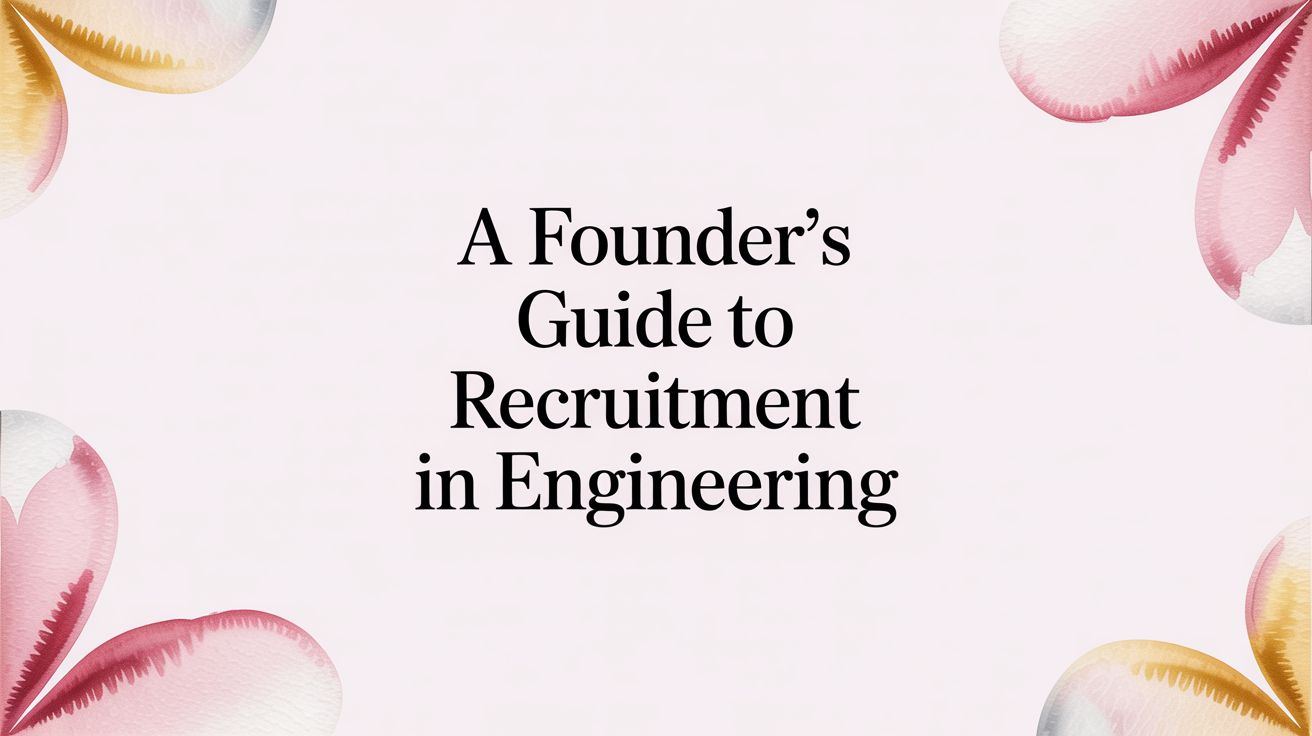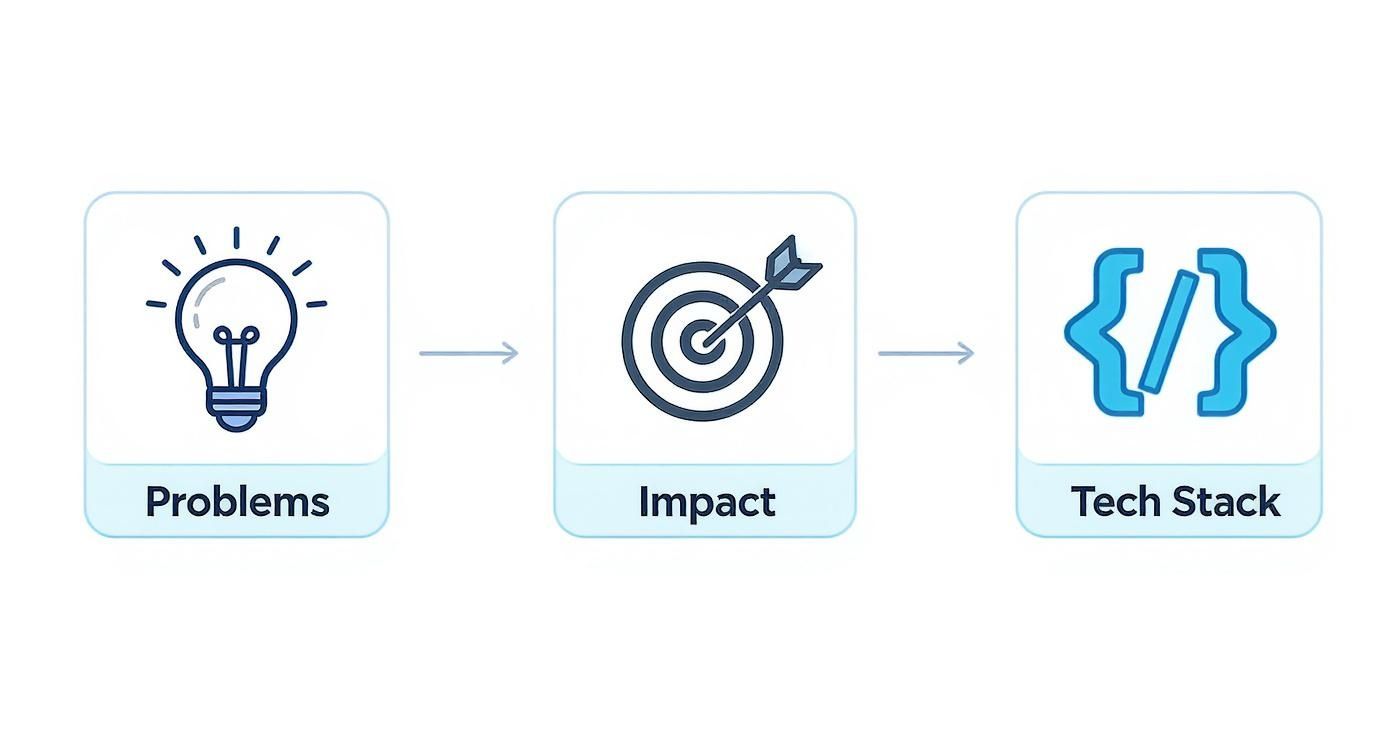
Let's be honest: recruiting engineers today feels less like following a playbook and more like jumping out of a plane without a parachute. Your job ads get ghosted, and the top 10% of talent disappears faster than free pizza on a Friday.
Turns out there’s more than one way to hire elite developers without mortgaging your office ping-pong table.

The market isn't just different; it's a completely different planet. Demand for niche skills in AI, robotics, and other arcane arts has exploded, but the talent pool hasn't kept up. The best engineers aren’t scrolling job boards; they’re getting headhunted for roles designed just for them.
This means your traditional recruitment channels are delivering a negative ROI. Posting an opening on Monster or LinkedIn has become the equivalent of shouting into a void.
As of May 2025, the UK engineering workforce hit 6.4 million, yet the country still faces an annual shortfall of 37,000–59,000 engineers. And that's just the UK. This isn’t a local problem; it’s a global one, forcing companies everywhere to completely rethink how they find people. You can read the full research on global engineering shortages to see just how deep the rabbit hole goes.
So what does this mean for you, on the ground?
Here’s the secret: the most sought-after engineers aren't looking for a job. They’re passive candidates, which means you have to go to them. Forget the job boards and start scouring GitHub, open-source forums, and niche Slack channels—that’s where the real talent lives.
“If your response rate is under 10%, you’re fishing in a dried-up creek.”
Your outreach can't feel like a mass mail blast. It needs to be a personal invitation, a conversation starter. Get this right, and you can see a 5× improvement in response rates.
To truly succeed, you need a holistic approach that covers attraction, hiring, and retention. For a deeper dive into the concepts, it’s worth exploring some foundational Talent Management Strategies.
Ready to adapt? Here’s where to start:
A competitive salary isn't a differentiator anymore; it's the price of admission. The best engineers are asking about things like ownership of the architecture, clear growth paths, and the budget for their preferred tools. If your offer letter looks generic, it’s going straight to the trash.
They're looking for:
Benefits like remote work and extra vacation are great, but they've become standard expectations. The real currency in this market is career trust.
Trying to source talent manually is a surefire way to burn out your recruiters. This is where technology becomes your ally. Using AI-assisted search and screening tools can easily double your reach without doubling your headcount. It's about sending more personalized, relevant emails to the right inboxes.
Automating the top of your funnel can cut sourcing time by 60%, freeing up your team to focus on actual conversations instead of staring at spreadsheets.
Tools like automated resume parsers and skill-matching platforms are your sonar in a murky talent ocean. They turn cold lists into warm prospects, helping you find that signal in the noise.
Ultimately, the choice is simple: adapt or get left behind. Your next great hire depends on treating engineering recruitment as a core growth driver, not just an HR function.
Let's be blunt: your job description is your opening sales pitch, and most of them are terrible. If it reads like a generic corporate wish list stapled to a laundry list of programming languages, you've already lost.
Top engineers can smell a boring, bureaucratic role from a mile away, and they will swipe left so fast it’ll give you whiplash. The good news? It all starts by ditching the HR-speak and writing something a human—specifically, an engineer—would actually want to read. The goal isn't to list every possible requirement; it’s to sell the problem.
Engineers are builders. Problem-solvers. They couldn't care less about vague corporate missions or a long list of "responsibilities." What they want to know is what hard, interesting problems they'll get to sink their teeth into.
Instead of this sleepy corporate-speak:
Try framing it as a mission:
See the difference? One is a chore. The other is a challenge. One gets ignored; the other gets a second look. Frame the role around the technical mountains they’ll get to climb.
Your job description is competing for attention against everything else on the internet. If it’s not more interesting than a cat video, you’re doing it wrong.
Nobody likes a bait-and-switch. If your tech stack has some, let's say, vintage components, be upfront about it. Honesty builds trust and, more importantly, it filters for the right kind of person—someone who sees a legacy system not as a deal-breaker, but as a puzzle to be solved.
Pretending you're an AI powerhouse when you're really held together by a five-year-old monolith is a recipe for a quick departure. Acknowledging your tech debt shows self-awareness. It signals that you're looking for someone to help fix it, which can be a huge draw for the right engineer.
For a deeper dive into structuring these critical documents, our guide on how to create job descriptions provides a more detailed framework that’s helped us attract top-tier talent.
Generic outreach is dead. A common mistake is treating job descriptions like a wide net. Instead, think of them as a highly targeted spear.
Write the description for one ideal person. Be so specific about the problems, the tech, and the team culture that your perfect candidate reads it and thinks, "Wait, did they write this for me?" This approach does more than attract the right people; it actively repels the wrong ones. You’ll get fewer applicants, but the ones you do get will be exponentially better.
Here's a quick checklist to gut-check your next job description:
Stop writing job descriptions that read like legal documents. Start writing compelling pitches that sell a mission. That’s how you win the war for engineering talent.
Let’s be honest: if you’re blasting InMails to every profile on LinkedIn, you’re barely scratching the surface. Top engineers spend their time writing code, not polishing headlines. They’ve become experts at spotting cookie-cutter messages and simply ignore them.
To reach these hidden gems, swap your salesperson hat for a scout’s mindset. Go to the places where real conversations happen—places HR seldom mentions.
We cling to the idea that every stellar developer is cataloged in one big database. It’s comforting but false. Real talent congregates in pockets where reputation is earned through effort, not purchased by ads.
Global hiring has opened doors to regions like Latin America. By tapping into remote-first communities there, you can uncover senior engineers who never show up in traditional searches. It’s an easy arbitrage if you know where to look.

This graphic drives home a simple point: engineers chase compelling challenges and modern tech stacks, not hollow buzzwords.
GitHub is the closest thing engineers have to a living résumé. But don’t be fooled by star counts. Instead:
This approach takes time, but you’re witnessing an engineer’s actual work and problem-solving style. It’s far more telling than any resume.
Forget cold outreach. Your new strategy is “warm observation.” Watch, appreciate, then spark a conversation about a problem they’d love to solve.
Engineers don’t hang out in job-board lobbies. They share war stories in tight-knit groups. Your role? Listen first, post later.
Building presence is a marathon, not a sprint. To get started on this long-term strategy, check out our guide on how to build a talent pipeline that delivers consistently.
Here's a cold, hard look at common sourcing channels and how a founder-led twist can actually make them work.
| Channel | Common Approach (Low ROI) | Founder-Led Approach (High ROI) | Effort vs. Reward |
|---|---|---|---|
| Job Boards | Broad postings, generic filters | Targeted roles on specialist forums with founder notes | Low effort, low yield |
| LinkedIn Recruiter | Mass InMails, auto-sequences | Personal messages referencing their open-source work | Medium effort, low yield |
| Recruitment Agencies | Bulk résumé submissions | Agencies briefed on culture and tech details by founders | High cost, mixed quality |
| Referrals | “Share this link on your feed” | One-on-one ask: “Who’s the best coder you’ve mentored?” | Low effort, high quality |
| Meetups & Conferences | Booth presence and swag give-aways | Host a workshop or lightning talk to attract real talent | Medium effort, high yield |
The table doesn't lie: a personal touch and founder involvement can turn common tactics into high-signal strategies.
Your engineers know other engineers. Shocking, I know. But "share this on LinkedIn" won’t cut it. Instead:
That specificity turns a vague ask into a powerful referral. It respects their time and taps into real insights, not just polished profiles.
So, you’ve finally got a trickle of candidates. Now what? Hope you enjoy spending your afternoons fact-checking resumes and running technical interviews—because that’s now your full-time job.
Unless, of course, you stop the madness.
Let’s just get one thing straight: the traditional screening process is broken. It’s a theatrical performance designed to make interviewers feel smart, not to actually identify great engineers.
The entire landscape of recruitment in engineering has been reshaped by a simple imbalance of supply and demand. Demand for engineering roles is set to jump by 13% by 2031, with AI and Machine Learning specialists becoming the most sought-after talent. This high-demand, low-supply market means candidates hold all the cards. Old-school, painful screening processes are a one-way ticket to getting ghosted. You can dig deeper into these engineering hiring trends on hirecruiting.com.
Ah, the whiteboard interview. That beloved hazing ritual where we ask a perfectly good engineer to solve a complex algorithm puzzle, by hand, in front of an audience. It’s stressful, unrealistic, and proves absolutely nothing about their ability to build and ship real-world software.
It’s the equivalent of asking a chef to cook a gourmet meal using only a pocket knife and a campfire. Sure, it’s a test of something, but not of their day-to-day skills. You’re testing for performance anxiety and rote memorization, not engineering competence.
Stop asking, “Can you invert a binary tree on this whiteboard?” and start asking, “Can you solve a problem that looks suspiciously like one our team tackled last quarter?”
The goal is to simulate the job, not a computer science exam from 1998. Your screening process should feel like a collaborative problem-solving session, not an interrogation.
Take-home assignments can be a fantastic signal, or they can be a massive, unpaid-labor red flag. The difference is all in the design.
Here’s how to do it right:
This isn't just about being nice; it's about getting better data. You can learn more about designing effective skills evaluations with our detailed guide on pre-employment skills testing.
Technical skills are only half the equation. A developer who can write flawless code but destroys team morale is a net negative. Your screening process needs to sniff out the difference between a genuine team player and a "brilliant jerk."
This is where behavioral questions come in, but not the tired old "what’s your greatest weakness?" nonsense.
Ask questions that reveal how they handle real-world friction:
Listen for humility, self-awareness, and a collaborative mindset. The best engineers are confident but not arrogant; they see feedback as a gift, not an attack. Building a process that filters for these traits is how you build a team that actually lasts.

So you found them. They aced every interview, your team loves them, and you’re already mentally assigning them their first project. And then… crickets. Welcome to the offer stage, the graveyard where promising hires go to die.
If you think this final step is just about sliding a PDF with a big number on it into their inbox, you’ve already lost. The offer isn't a transaction; it's the climax of the entire story you've been telling them. And if your story has plot holes, they’ll find a better one.
Too many founders treat the salary discussion like a top-secret negotiation, holding it back until the very end. This is a rookie mistake. By the time you make an offer, the salary should be a confirmation of what’s already been discussed, not a surprise.
Set expectations from the very first call. Ask them, "To make sure we're not wasting anyone's time, what sort of compensation range are you targeting for your next role?" It’s a direct, respectful question that frames the conversation transparently. No games, no lowballing.
Your offer letter shouldn't be a proposal; it should be a formality. If the candidate is surprised by anything in it—salary, equity, or start date—you messed up somewhere in the process.
This isn’t just about being nice; it’s about efficiency. Aligning on salary early on filters out bad fits and builds a foundation of trust.
Let’s be brutally honest: your dream candidate is also three other companies' dream candidate. While you’re waiting for your board to approve the equity grant, your competitor is already sending over a DocuSign. The market for top engineering talent moves at a blistering pace, and slowness is a fatal flaw.
A great candidate experience is defined by momentum. Here’s a simple, non-negotiable timeline:
Anything slower signals indecisiveness or, worse, that they aren’t a priority. You have to act like you want them, or you’ll watch them walk over to someone who does.
Of course, money matters. But once you’ve met the market rate, the decision often comes down to the intangibles. And no, I’m not talking about the office ping-pong table.
Top engineers are buying into a mission and a team. Your offer call should be a final sales pitch focused on what truly matters:
Just as sales teams guide prospects through a journey, recruiters manage a talent pipeline. Mastering the principles of building a high-converting B2B sales funnel can provide surprising insights into closing candidates. The offer stage is your "bottom of the funnel," where personalization and a clear value proposition are everything. Make it count.
If you’re only tracking "time-to-fill" and "cost-per-hire," you’re flying blind. Those are vanity metrics. They tell you how busy your HR team is, not whether your engineering recruitment is actually any good.
It’s like measuring a restaurant’s success by how quickly they get food on the table, without ever checking if it's edible. It's time to stop reacting and start recruiting intelligently.
Let’s talk about the KPIs that truly define a successful engineering hiring engine. These aren't just numbers for a spreadsheet; they're the vital signs that tell you what’s working, what’s broken, and where your next great hire is hiding.
Get these right, and you'll have a dashboard that actually informs your strategy. You’ll stop guessing and start making decisions backed by real data.
Here are the big three to get you started:
Understanding the broader market also adds crucial context to your metrics. The software engineering job market is still cautious, with positions down around 22% from their 2022 peaks. Big Tech has slashed new graduate hiring, which now makes up just 7% of their intake.
Yet, giants like Meta and Google have roared back, increasing their engineering headcount by 19% and 16% respectively over 2022 levels. You can discover more insights about this stratified tech market on pragmaticengineer.com. This tells us that while entry-level talent faces hurdles, the battle for experienced engineers is still fierce.
"Data tells you a story. If your story is 'we hired someone fast,' you’re missing the entire plot. The real story is 'we hired someone who shipped game-changing code in their first quarter.'"
Ultimately, measuring the right things is about accountability. It forces you to be honest about your process, from the first outreach to the final offer. It's how you turn engineering recruitment from a chaotic cost center into a predictable growth driver.
Look, we get it. Even with a solid game plan, the world of engineering recruitment is full of "what ifs" and lingering doubts. Let's tackle a few of the big ones head-on, founder to founder.
You're asking the wrong question. Stop thinking about a simple recruiter fee and start thinking about the total cost of that empty seat.
The real cost is a messy cocktail of your team's time sunk into endless interviews, the catastrophic price of a bad hire, and the opportunity cost bleeding your roadmap dry. A quality hire isn't an expense; it's a high-yield investment.
For a senior role in a hot field like AI or DevOps, the total acquisition cost will be substantial. So, ask a better question: "What's the cost of not having this person on my team for another six months?" Suddenly, the budget conversation gets a lot clearer.
Being slow. Full stop.
The market moves at the speed of a git commit. Your ideal candidate is probably in the final stages with three other companies by the time your internal bureaucracy approves the first interview. A sluggish, multi-stage process with dead air between calls is a guaranteed way to lose top talent.
You have to be decisive, responsive, and treat the candidate's time as more valuable than your own.
Your interview loop should be a well-oiled machine, not a slow-motion train wreck. Condense it, give feedback immediately, and make a decision before your competition does.
It's not a cage match; it's about picking the right tool for the job.
An in-house recruiter is fantastic for sustained, long-term hiring, but they take time to ramp up and build a network from scratch. A specialized agency, on the other hand, can be your special forces—parachuting in with a shortlist of high-quality candidates for a critical, hard-to-fill role right now.
The smartest move is often a hybrid approach. Use a great agency for that urgent, time-sensitive hire while you build your internal capacity. Don't frame it as an either/or dilemma. Think of it as having both a scalpel and a sledgehammer in your toolbox. You'll need both eventually.